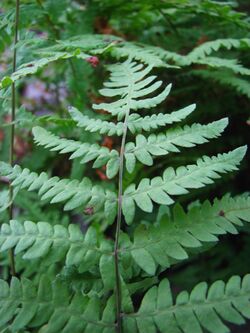Biology:Thelypteris palustris
| Thelypteris palustris | |
|---|---|

| |
| Scientific classification | |
| Kingdom: | Plantae |
| Clade: | Tracheophytes |
| Division: | Polypodiophyta |
| Class: | Polypodiopsida |
| Order: | Polypodiales |
| Suborder: | Aspleniineae |
| Family: | Thelypteridaceae |
| Genus: | Thelypteris |
| Species: | T. palustris
|
| Binomial name | |
| Thelypteris palustris | |
| Synonyms[2] | |
|
List
| |
Thelypteris palustris, the marsh fern,[3] or eastern marsh fern,[4] is a species of fern native to eastern North America and across Eurasia. It prefers to grow in swamps, bogs, wet fields or thickets, fresh tidal and nontidal marshes, or wooded streambanks. The species epithet palustris is Latin for "of the marsh" and indicates its common habitat.[5] It is the only known host plant for Fagitana littera, the marsh fern moth.[6]
Description
Fronds of T.palustris are erect to ascending with an elliptic to lanceolate form. They are 1-2.5 ft long and 4-7 inches across and have 10-40 pairs of leaflets. Its leaves are pinnately lobed, with the middle pinna being the widest. The leaves are more than 6 inches long, and the 3-6 inches wide. Sori are present on the undersides of the smaller fertile leaves.[7]
The stem is tan to purplish and hairless.
Uses
T.palustris has been studied for potential uses in phytoremediation. T.palustris has been shown to significantly reduce the amount of Zn2+ and Cu2+, which are the main outputs of heavy metal from intensive livestock production, ex situ.[8] There have been mixed results for whether T.palustris would be a good candidate for remediation of arsenic soil contamination.[9][10]
Subtaxa
The following subspecies are accepted:[2]
- Thelypteris palustris subsp. palustris
- Thelypteris palustris subsp. pubescens (G.Lawson) Fraser-Jenk.
References
- ↑ "NatureServe Explorer 2.0 - Thelypteris palustris Eastern Marsh Fern". https://explorer.natureserve.org/Taxon/ELEMENT_GLOBAL.2.128026/Thelypteris_palustris. Retrieved 9 October 2020.
- ↑ 2.0 2.1 "Thelypteris palustris Schott" (in en). Royal Botanic Gardens, Kew. http://www.plantsoftheworldonline.org/taxon/746249-1.
- ↑ (xls) BSBI List 2007, Botanical Society of Britain and Ireland, https://bsbi.org/download/3542/, retrieved 2014-10-17
- ↑ "Thelypteris palustris". Natural Resources Conservation Service PLANTS Database. USDA. https://plants.usda.gov/core/profile?symbol=THPA. Retrieved 9 December 2015.
- ↑ Archibald William Smith A Gardener's Handbook of Plant Names: Their Meanings and Origins , p. 258, at Google Books
- ↑ Pocketguide to Eastern Wetlands By T. Travis, Shanda Brown p.57, 2014
- ↑ "Thelypteris palustris var. pubescens (Eastern Marsh Fern, Marsh Fern) | North Carolina Extension Gardener Plant Toolbox". https://plants.ces.ncsu.edu/plants/thelypteris-palustris-var-pubescens/.
- ↑ Stroppa, Nadia; Onelli, Elisabetta; Hejna, Monika; Rossi, Luciana; Gagliardi, Assunta; Bini, Luca; Baldi, Antonella; Moscatelli, Alessandra (2020-02-01). "Typha latifolia and Thelypteris palustris behavior in a pilot system for the refinement of livestock wastewaters: A case of study" (in en). Chemosphere 240: 124915. doi:10.1016/j.chemosphere.2019.124915. ISSN 0045-6535. PMID 31563105. Bibcode: 2020Chmsp.240l4915S. https://www.sciencedirect.com/science/article/pii/S004565351932154X.
- ↑ Anderson, LaShunda L.; Walsh, Maud; Roy, Amitava; Bianchetti, Christopher M.; Merchan, Gregory (February 2011). "The potential of Thelypteris palustris and Asparagus sprengeri in phytoremediation of arsenic contamination". International Journal of Phytoremediation 13 (2): 177–184. doi:10.1080/15226511003671346. ISSN 1522-6514. PMID 21598785. https://pubmed.ncbi.nlm.nih.gov/21598785/.
- ↑ Anderson, LaShunda; Walsh, Maud M. (2007-07-01). "Arsenic uptake by common marsh fern Thelypteris palustris and its potential for phytoremediation" (in en). Science of the Total Environment. Arsenic in the Environment: Biology and Chemistry 379 (2): 263–265. doi:10.1016/j.scitotenv.2006.09.032. ISSN 0048-9697. PMID 17113631. Bibcode: 2007ScTEn.379..263A. https://www.sciencedirect.com/science/article/pii/S0048969706007728.
Wikidata ☰ Q958103 entry
 |


